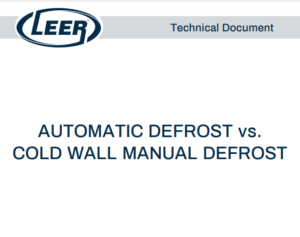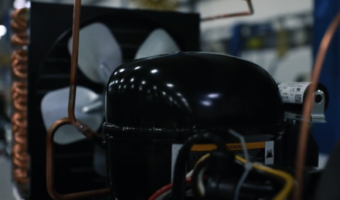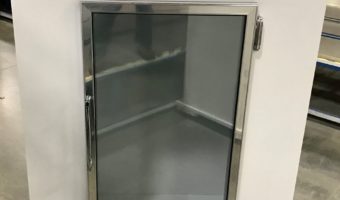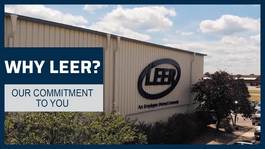Purpose
All refrigerated units, including Ice Merchandisers & Ice Vending Machines, need a defrost system. Otherwise frost would build up, on the walls or the product itself, creating hours of work for you chipping away.
To keep this from happening, there are two defrost options: Automatic Defrost Units and Cold Wall Manual Defrost Units.
Because each defrost option has advantages and disadvantages in different situations, keep reading to learn more about each type and when you should purchase one versus the other.
Note: On our website, products available in Cold Wall will have a ‘CW’ bubble next to the product name. Similarly, products available in Auto Defrost will have a ‘AD’ bubble.
Or, download the full Technical Documentation here!
What is Automatic Defrost?
Automatic Defrost units are exactly what they sound like: they automatically defrost their interior. This option is perfect for merchandisers who want to avoid frost build up and don’t want to manually melt and remove it.
In these units, the interior roof of the unit contains an evaporator assembly with fans to circulate air. Frost builds up on these fans and the Automatic Defrost system will follow calculated parameters, running a heating cycle, to warm the evaporator and melt this frost build-up. Once the frost melts, it’s channeled to the rear of the unit and into a drain tube.
There are indoor and outdoor options for Automatic Defrost Units. The primary difference is in outdoor units, the drip from the melted frost will drip directly onto the ground. In indoor units, a condensate evaporator pan is provided to catch the runoff and has a built-in heating element to quickly evaporate the water.
Advantages of Automatic Defrost
- Ease of Maintenance – the defrost option is done automatically. No manual steps needed.
- Shorter Recovery Time – opening the door lets in warmer air. When you close the door, Automatic Defrost will get the internal temperature back to the proper temperature faster by forcing air through the evaporator coils.
- Impact on Packaged Ice – no need to remove and manually defrost your packaged ice.
Disadvantages of Automatic Defrost
- Additional Moving Parts – additional elements like the evaporator fans, evaporator heat element, defrost termination safety switch and condensate evaporator (if used) can wear out or become damaged.
- Consistent Drip – water from the melted frost will drip continuously from the back of the unit. This can be easily caught by placing a condensate evaporator pan (required for indoor units) and will use heat to evaporate the accumulated water.
- Slightly Increased Energy Costs – because the defrost heating cycles run constantly, Auto Defrost units have slightly higher energy consumption and amperage draw than similar-sized Cold Wall units.
- Slightly Decreased Capacity – due to the evaporator fan and air ducts on the unit, Auto Defrost Units have a slightly larger footprint.
- Higher Cost – on most models, the purchase price is higher but not by much.
What is Cold Wall Manual Defrost?
In Cold Wall Manual Defrost Units, inside of the foamed wall has copper tubing, which acts as the evaporator. This tubing is strategically placed around the walls and ceiling to evenly remove heat. Where the evaporator tubing is present, frost will form as it freezes moisture from the air. Over time, this buildup will need to be manually removed to achieve the best performance.
Unlike Automatic Defrost units, any frost will need to be manually removed and the refrigeration system turned off. When doing this, you can let the ambient heat melt the frost. Or, to speed up the defrosting process, you can add heat or carefully use a plastic scraper. The melted frost will puddle at the bottom of the unit.
For outdoor units, it’s common to drain the water directly into via the drain plug. On indoor units, carefully absorb the melted frost with a towel or wet vac to avoid it refreezing once the refrigeration is powered back on.
Advantages of Cold Wall Manual Defrost
- Fewer Moving Parts – the evaporator copper coils are foamed in place to ensure no moving parts.
- Less Replacement Parts – there are fewer parts than the Automatic Defrost, so there are fewer system parts that need to be replaced.
- No Drip – there is no continuous drainage of the melted frost.
- Slightly Lower Energy Costs – without the heating cycles of Automatic Defrost systems, Cold Wall units have lower energy consumption and amperage draw than similar-sized Auto Defrost units.
- Slightly Increased Capacity – there are no evaporator fans or air ducts to consume space so the carrying capacity is greater.
- Lower Cost – because there are fewer bells and whistles, the cost is slightly lower for most models.
Disadvantages of Cold Wall Manual Defrost
- Additional Labor – like its name, Cold Wall Manual Defrost units require a manual defrost process and offers no automatic assistance.
- Longer Recovery – because it doesn’t have an evaporator fan, the Cold Wall unit will take longer to recover back to the correct temperature after the doors were opened.
- Impact on Packaged Ice – if you store packaged ice, you will need to manually defrost the ice.
What to Consider When Making Your Decision
Both Automatic Defrost and Cold Wall Manual Defrost refrigerated units can meet your needs and choosing between them is ultimately a personal preference. Some factors to consider are price, available space, and needed capacity.
That said, there are two cases where you will want to choose one over the other.
- High Humidity Locations – if the location of your refrigerated unit is typically humid, opt for the Automatic Defrost option. The defrost control settings are adjustable, which will minimize the increased frost caused by the humidity.
- Maximizing Capacity – if your main priority is to maximize your refrigerated unit’s storage capacity, choose the Cold Wall Manual Defrost option, as there are no interior fans or air ducts taking up space.
Do you already have a refrigerated unit? Here’s how to tell which defrost option you have.
First, check the serial tag, which should tell you which type of refrigerated unit you have. Next, both have distinctive features that can give you a clue.
Automatic Defrost units have evaporator housing with fans on the interior roof. They also have a drain tube and/or a condensate evaporator pan on the inside and rear of the unit. Finally, they have air ducts on the inside walls.
Cold Wall Manual Defrost units do not have an evaporator on the interior roof, do not have a drain tube on the inside and rear, and do not have interior air ducts. They do have identifiable frost patterns form on the interior walls.
Choosing the right refrigerated unit is important to keep your product in premium condition. Your answer to which type of unit you should choose will depend on a number of factors including, capacity, humidity levels, and the amount of manual labor you’re able to put into defrosting the unit.
Click here to learn more about Leer’s defrost options and to discuss which would be best for your refrigerated unit needs. Or, click here to download the full Technical Documentation!
If you enjoyed this blog, subscribe to our temperature-controlled storage solutions newsletter!




